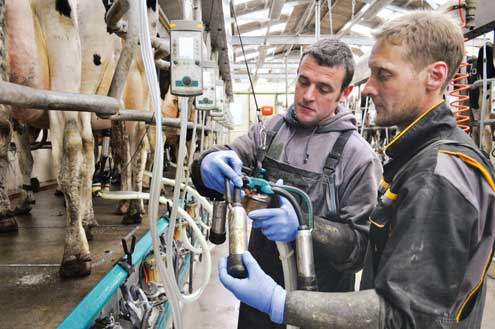On-farm service helps reduce cell counts

Investing in an independent pair of eyes to observe parlour routine has resulted in considerable savings for a Shropshire dairy farmer.
The Wyndford herd of 230 pedigree Holsteins are well known as high-quality show winners, combining performance – an average 10,000 litres/cow – with type.
So, when a new 24:24 parlour was installed in 2010, expectations were high that performance would improve even further and as a result, herd manager Ben Yates set a target for quicker milking times, improved teat health and a yield increase. However, instead of this, Mr Yates saw cell counts gradually rise.
| Farm facts |
|---|
|
“Slowly, over a few months, we noticed cell counts gradually creeping up from our previous level of 160,000 cells/ml to about 250,000 cells/ml,” says Mr Yates.
Assuming all was well with the newly-installed parlour, the team looked at all non-parlour areas, from bedding to standing time, milking routine to hygiene. The herd is housed in a facility that was built on a greenfield site and includes some of the most up-to-date facilities available; and careful scrutiny of all areas seemed to indicate it was not the cause of the problems.
“Various engineers from the dealer and manufacturer came in to look at the parlour, but we didn’t seem to be making any progress towards diagnosing the problem,” he explains.
So, after advice from his regular vet Bill May, from Lambert Leonard and May, Mr Yates called on milking parlour consultancy Precision Milking .
The consultancy service, which is headed up by James Allcock, worked alongside the GEA experts to establish a plan the farm team could implement to tackle the issue.
“Having someone on the farm such as Mr Allcock, who is completely independent and combines veterinary understanding with milking machine expertise, meant we could look at the problem in a new way,” says Mr Yates.
“Mr Allcock came in to milk alongside us, carefully observing teats as soon as the cluster was removed, checking shape, colour, ringing and so on. He also ran a full dynamic test on the parlour.”
The examinations showed evidence of liner slip and significant teat barrel congestion, especially on some of the smaller teated cows.
“Teat congestion can be associated with high infection rates and it was clear that machine-related issues were involved in the rise in mastitis and cell counts,” Mr Allcock explains. “Some of the genetically advanced heifers in the herd had very small teats, meaning they could not fully fill the liner, with the result that liner mouthpiece chamber vacuums were high throughout milking – and this resulted in clear signs of congestion.
“Researchers from Tine, the milking time specialist advisers in Norway, has shown that of all the records that can be monitored during milking, it is higher-than-desirable liner mouthpiece chamber vacuums that are most positively linked with milk quality financial losses,” he adds. The result of the exercise has been to turn up vacuum by 1kPa and to alter the take-off threshold while tightening up prep routines. Cell counts have now dropped to 130,000 cells/ml.
“Having an independent and expert extra pair of eyes here, observing how the parlour was working has meant we have simply had to tweak a couple of settings to solve the problem so avoiding any additional significant adaptations to the parlour,” says Mr Yates.
| Precision milking summary |
|---|
|
